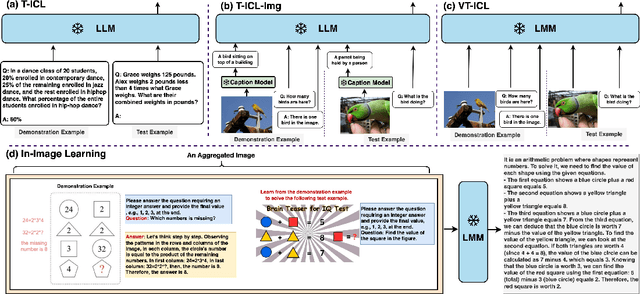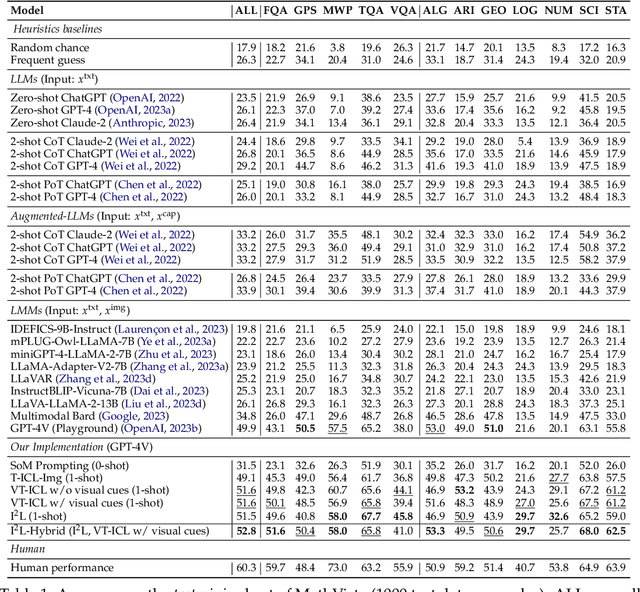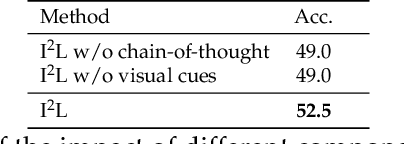Ee-Peng Lim
Effects of Theory of Mind and Prosocial Beliefs on Steering Human-Aligned Behaviors of LLMs in Ultimatum Games
May 30, 2025Abstract:Large Language Models (LLMs) have shown potential in simulating human behaviors and performing theory-of-mind (ToM) reasoning, a crucial skill for complex social interactions. In this study, we investigate the role of ToM reasoning in aligning agentic behaviors with human norms in negotiation tasks, using the ultimatum game as a controlled environment. We initialized LLM agents with different prosocial beliefs (including Greedy, Fair, and Selfless) and reasoning methods like chain-of-thought (CoT) and varying ToM levels, and examined their decision-making processes across diverse LLMs, including reasoning models like o3-mini and DeepSeek-R1 Distilled Qwen 32B. Results from 2,700 simulations indicated that ToM reasoning enhances behavior alignment, decision-making consistency, and negotiation outcomes. Consistent with previous findings, reasoning models exhibit limited capability compared to models with ToM reasoning, different roles of the game benefits with different orders of ToM reasoning. Our findings contribute to the understanding of ToM's role in enhancing human-AI interaction and cooperative decision-making. The code used for our experiments can be found at https://github.com/Stealth-py/UltimatumToM.
Advancing Food Nutrition Estimation via Visual-Ingredient Feature Fusion
May 13, 2025Abstract:Nutrition estimation is an important component of promoting healthy eating and mitigating diet-related health risks. Despite advances in tasks such as food classification and ingredient recognition, progress in nutrition estimation is limited due to the lack of datasets with nutritional annotations. To address this issue, we introduce FastFood, a dataset with 84,446 images across 908 fast food categories, featuring ingredient and nutritional annotations. In addition, we propose a new model-agnostic Visual-Ingredient Feature Fusion (VIF$^2$) method to enhance nutrition estimation by integrating visual and ingredient features. Ingredient robustness is improved through synonym replacement and resampling strategies during training. The ingredient-aware visual feature fusion module combines ingredient features and visual representation to achieve accurate nutritional prediction. During testing, ingredient predictions are refined using large multimodal models by data augmentation and majority voting. Our experiments on both FastFood and Nutrition5k datasets validate the effectiveness of our proposed method built in different backbones (e.g., Resnet, InceptionV3 and ViT), which demonstrates the importance of ingredient information in nutrition estimation. https://huiyanqi.github.io/fastfood-nutrition-estimation/.
A Multi-Stage Framework with Taxonomy-Guided Reasoning for Occupation Classification Using Large Language Models
Mar 17, 2025Abstract:Automatically annotating job data with standardized occupations from taxonomies, known as occupation classification, is crucial for labor market analysis. However, this task is often hindered by data scarcity and the challenges of manual annotations. While large language models (LLMs) hold promise due to their extensive world knowledge and in-context learning capabilities, their effectiveness depends on their knowledge of occupational taxonomies, which remains unclear. In this study, we assess the ability of LLMs to generate precise taxonomic entities from taxonomy, highlighting their limitations. To address these challenges, we propose a multi-stage framework consisting of inference, retrieval, and reranking stages, which integrates taxonomy-guided reasoning examples to enhance performance by aligning outputs with taxonomic knowledge. Evaluations on a large-scale dataset show significant improvements in classification accuracy. Furthermore, we demonstrate the framework's adaptability for multi-label skill classification. Our results indicate that the framework outperforms existing LLM-based methods, offering a practical and scalable solution for occupation classification and related tasks across LLMs.
MathHay: An Automated Benchmark for Long-Context Mathematical Reasoning in LLMs
Oct 07, 2024



Abstract:Recent large language models (LLMs) have demonstrated versatile capabilities in long-context scenarios. Although some recent benchmarks have been developed to evaluate the long-context capabilities of LLMs, there is a lack of benchmarks evaluating the mathematical reasoning abilities of LLMs over long contexts, which is crucial for LLMs' application in real-world scenarios. In this paper, we introduce MathHay, an automated benchmark designed to assess the long-context mathematical reasoning capabilities of LLMs. Unlike previous benchmarks like Needle in a Haystack, which focus primarily on information retrieval within long texts, MathHay demands models with both information-seeking and complex mathematical reasoning abilities. We conduct extensive experiments on MathHay to assess the long-context mathematical reasoning abilities of eight top-performing LLMs. Even the best-performing model, Gemini-1.5-Pro-002, still struggles with mathematical reasoning over long contexts, achieving only 51.26% accuracy at 128K tokens. This highlights the significant room for improvement on the MathHay benchmark.
Speaker Verification in Agent-Generated Conversations
May 16, 2024Abstract:The recent success of large language models (LLMs) has attracted widespread interest to develop role-playing conversational agents personalized to the characteristics and styles of different speakers to enhance their abilities to perform both general and special purpose dialogue tasks. However, the ability to personalize the generated utterances to speakers, whether conducted by human or LLM, has not been well studied. To bridge this gap, our study introduces a novel evaluation challenge: speaker verification in agent-generated conversations, which aimed to verify whether two sets of utterances originate from the same speaker. To this end, we assemble a large dataset collection encompassing thousands of speakers and their utterances. We also develop and evaluate speaker verification models under experiment setups. We further utilize the speaker verification models to evaluate the personalization abilities of LLM-based role-playing models. Comprehensive experiments suggest that the current role-playing models fail in accurately mimicking speakers, primarily due to their inherent linguistic characteristics.
OVFoodSeg: Elevating Open-Vocabulary Food Image Segmentation via Image-Informed Textual Representation
Apr 01, 2024Abstract:In the realm of food computing, segmenting ingredients from images poses substantial challenges due to the large intra-class variance among the same ingredients, the emergence of new ingredients, and the high annotation costs associated with large food segmentation datasets. Existing approaches primarily utilize a closed-vocabulary and static text embeddings setting. These methods often fall short in effectively handling the ingredients, particularly new and diverse ones. In response to these limitations, we introduce OVFoodSeg, a framework that adopts an open-vocabulary setting and enhances text embeddings with visual context. By integrating vision-language models (VLMs), our approach enriches text embedding with image-specific information through two innovative modules, eg, an image-to-text learner FoodLearner and an Image-Informed Text Encoder. The training process of OVFoodSeg is divided into two stages: the pre-training of FoodLearner and the subsequent learning phase for segmentation. The pre-training phase equips FoodLearner with the capability to align visual information with corresponding textual representations that are specifically related to food, while the second phase adapts both the FoodLearner and the Image-Informed Text Encoder for the segmentation task. By addressing the deficiencies of previous models, OVFoodSeg demonstrates a significant improvement, achieving an 4.9\% increase in mean Intersection over Union (mIoU) on the FoodSeg103 dataset, setting a new milestone for food image segmentation.
The Whole is Better than the Sum: Using Aggregated Demonstrations in In-Context Learning for Sequential Recommendation
Mar 15, 2024Abstract:Large language models (LLMs) have shown excellent performance on various NLP tasks. To use LLMs as strong sequential recommenders, we explore the in-context learning approach to sequential recommendation. We investigate the effects of instruction format, task consistency, demonstration selection, and number of demonstrations. As increasing the number of demonstrations in ICL does not improve accuracy despite using a long prompt, we propose a novel method called LLMSRec-Syn that incorporates multiple demonstration users into one aggregated demonstration. Our experiments on three recommendation datasets show that LLMSRec-Syn outperforms state-of-the-art LLM-based sequential recommendation methods. In some cases, LLMSRec-Syn can perform on par with or even better than supervised learning methods. Our code is publicly available at https://github.com/demoleiwang/LLMSRec_Syn.
All in a Single Image: Large Multimodal Models are In-Image Learners
Feb 28, 2024



Abstract:This paper introduces a new in-context learning (ICL) mechanism called In-Image Learning (I$^2$L) that combines demonstration examples, visual cues, and instructions into a single image to enhance the capabilities of GPT-4V. Unlike previous approaches that rely on converting images to text or incorporating visual input into language models, I$^2$L consolidates all information into one image and primarily leverages image processing, understanding, and reasoning abilities. This has several advantages: it avoids inaccurate textual descriptions of complex images, provides flexibility in positioning demonstration examples, reduces the input burden, and avoids exceeding input limits by eliminating the need for multiple images and lengthy text. To further combine the strengths of different ICL methods, we introduce an automatic strategy to select the appropriate ICL method for a data example in a given task. We conducted experiments on MathVista and Hallusionbench to test the effectiveness of I$^2$L in complex multimodal reasoning tasks and mitigating language hallucination and visual illusion. Additionally, we explored the impact of image resolution, the number of demonstration examples, and their positions on the effectiveness of I$^2$L. Our code is publicly available at https://github.com/AGI-Edgerunners/IIL.
Generative Semi-supervised Graph Anomaly Detection
Feb 19, 2024



Abstract:This work considers a practical semi-supervised graph anomaly detection (GAD) scenario, where part of the nodes in a graph are known to be normal, contrasting to the unsupervised setting in most GAD studies with a fully unlabeled graph. As expected, we find that having access to these normal nodes helps enhance the detection performance of existing unsupervised GAD methods when they are adapted to the semi-supervised setting. However, their utilization of these normal nodes is limited. In this paper, we propose a novel Generative GAD approach (GGAD) for the semi-supervised scenario to better exploit the normal nodes. The key idea is to generate outlier nodes that assimilate anomaly nodes in both local structure and node representations for providing effective negative node samples in training a discriminative one-class classifier. There have been many generative anomaly detection approaches, but they are designed for non-graph data, and as a result, they fail to take account of the graph structure information. Our approach tackles this problem by generating graph structure-aware outlier nodes that have asymmetric affinity separability from normal nodes while being enforced to achieve egocentric closeness to normal nodes in the node representation space. Comprehensive experiments on four real-world datasets are performed to establish a benchmark for semi-supervised GAD and show that GGAD substantially outperforms state-of-the-art unsupervised and semi-supervised GAD methods with varying numbers of training normal nodes. Code will be made available at https://github.com/mala-lab/GGAD.
Mitigating Fine-Grained Hallucination by Fine-Tuning Large Vision-Language Models with Caption Rewrites
Dec 04, 2023



Abstract:Large language models (LLMs) have shown remarkable performance in natural language processing (NLP) tasks. To comprehend and execute diverse human instructions over image data, instruction-tuned large vision-language models (LVLMs) have been introduced. However, LVLMs may suffer from different types of object hallucinations. Nevertheless, LVLMs are evaluated for coarse-grained object hallucinations only (i.e., generated objects non-existent in the input image). The fine-grained object attributes and behaviors non-existent in the image may still be generated but not measured by the current evaluation methods. In this paper, we thus focus on reducing fine-grained hallucinations of LVLMs. We propose \textit{ReCaption}, a framework that consists of two components: rewriting captions using ChatGPT and fine-tuning the instruction-tuned LVLMs on the rewritten captions. We also propose a fine-grained probing-based evaluation method named \textit{Fine-Grained Object Hallucination Evaluation} (\textit{FGHE}). Our experiment results demonstrate that ReCaption effectively reduces fine-grained object hallucination for different LVLM options and improves their text generation quality. The code can be found at https://github.com/Anonymousanoy/FOHE.
 Add to Chrome
Add to Chrome Add to Firefox
Add to Firefox Add to Edge
Add to Edge